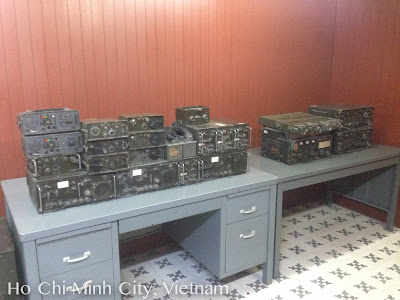Our first stop was the Reunification Palace. The site of the palace was originally occupied by Norodom palace, and was the residence of the French colonial governor. Norodom palace was handed over to the southern State of Vietnam after the fall of the French and the state of the Geneva Accords in 1954. It remained the residence of the President of the State of Vietnam until it was bombed in 1962 by two pilots sympathetic to the Viet Cong. As such the existing structure was demolished and the current structure was erected. Independence Palace was completed in 1966 and was the seat of the South Vietnamese government until it fell to the North Vietnamese in 1975, at which time it was renamed the Reunification Palace.
While the building is no longer used as a residence, the large dining and meeting rooms are still used for official functions. The central corridors all are open air and the breeze filters through the openings in the hour glass facade. Despite the lack of air conditioning, it was actually quite cool. While we were wandering through the rooms we were stopped by a pair of Vietnamese women so they could take pictures of us. We have no idea why. Beneath the palace is a bunker containing rooms for the president and his family as well as radio equipment and maps of the country tracking the progress of the conflict.
The roof of the palace sports the helicopters used by the Viet Cong to bomb the palace in 1975, shortly before land forces crashed through the gates with tanks. While the bombs did not do significant structural damage to the overall structure there are two large outlines of where the bombs hit.
After the reunification palace we stopped for cold beverages and air conditioning at a cafe before heading to the central market for lunch. I had an excellent mango smoothie at the cafe and then we had two different kinds of pork on a stick for lunch. Both were quite delicious, one was covered in peanuts.
After lunch we walked over to the War Remnants Museum which deals with the American involvement in the Vietnam war. On the way we were very skillfully conned into buying fresh coconut juice in the coconut. The seller was walking next to us on the sidewalk and put his yoke on Chris' shoulder's, he then chopped open two coconuts and offered them to us without asking - he then asked for money. We probably would not have purchased coconut water otherwise, but it was a good photo op and the coconut water was cold, which was nice.
The ground floor of the war museum was dedicated to an exhibit describing how well American POWs were treated in captivity. I have to admit that it was a bit hard to swallow. There were also several walls of anti-war propaganda from around the world - which was interesting. The upper floors were dedicated to war atrocities, weapons, and the lingering effects of chemical warfare. Those were hard to swallow as well - but in an entirely different way. The best exhibit was a tribute to war photographers who died in action on both sides. That one was striking for the numbers of photographers that died in war related accidents as opposed to actual warfare. One, for instance, died when the pilot decided to fly closer to mount Fuji while en route to Vietnam and subsequently crashed the plane into the mountain. At the war museum the exhibits are air conditioned, but the hallways between them are not, and there are a lot of stairs, so by the time we were done we were ready to head home.
Thanks for reading!
-Chris and Kim
Stay tuned for more tails from the other side of the world!
Interested in something particular about trip? Drop us a comment or email and we'll post about it! Email





No comments:
Post a Comment